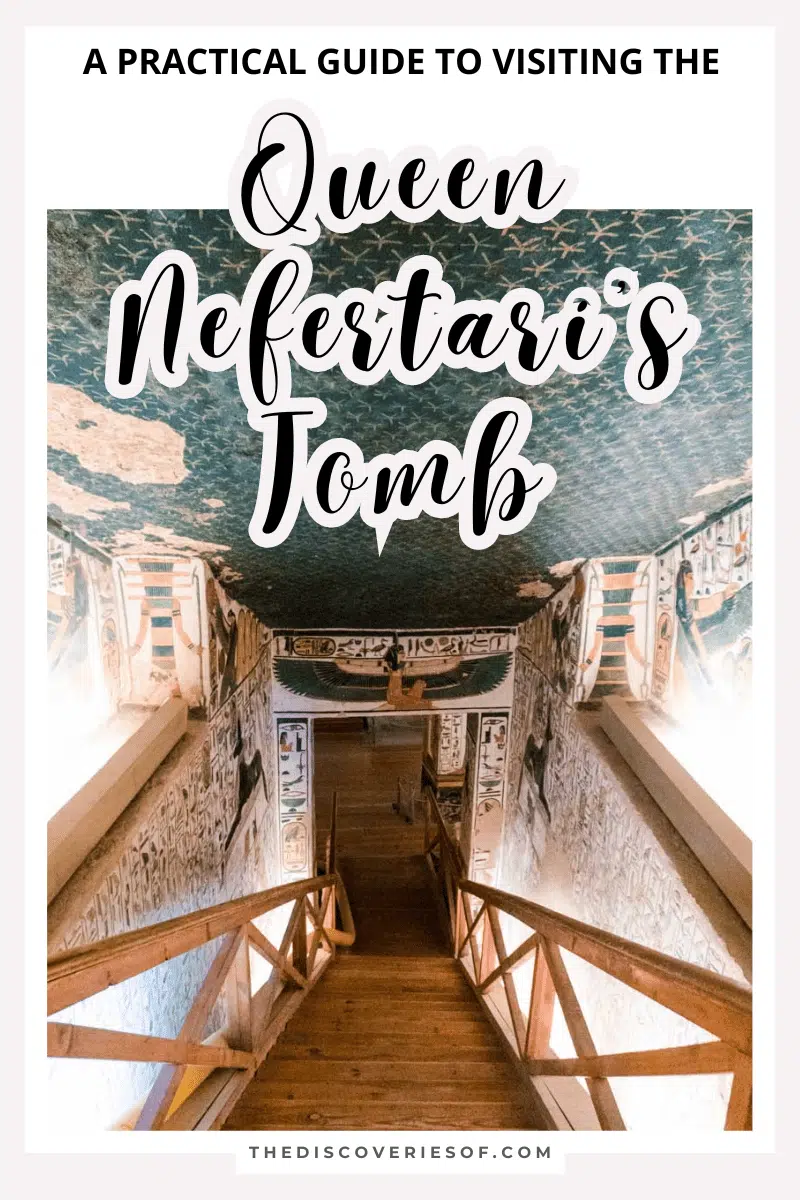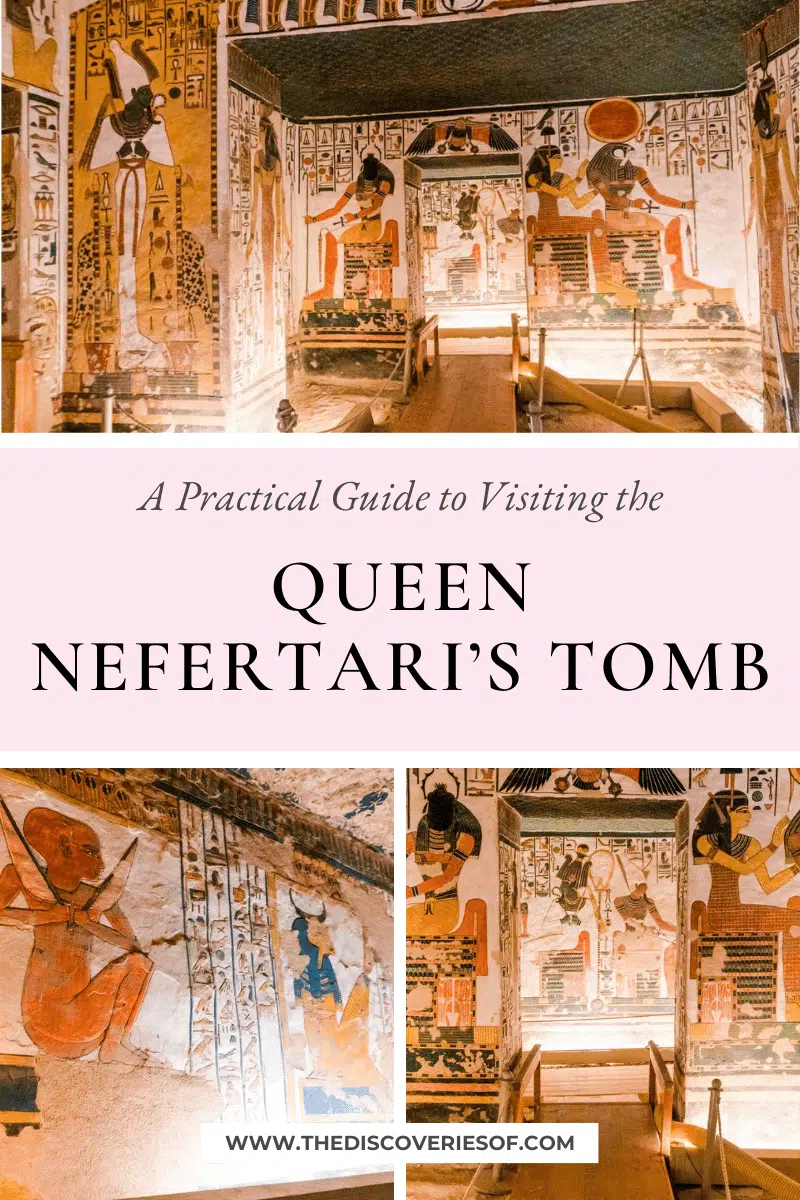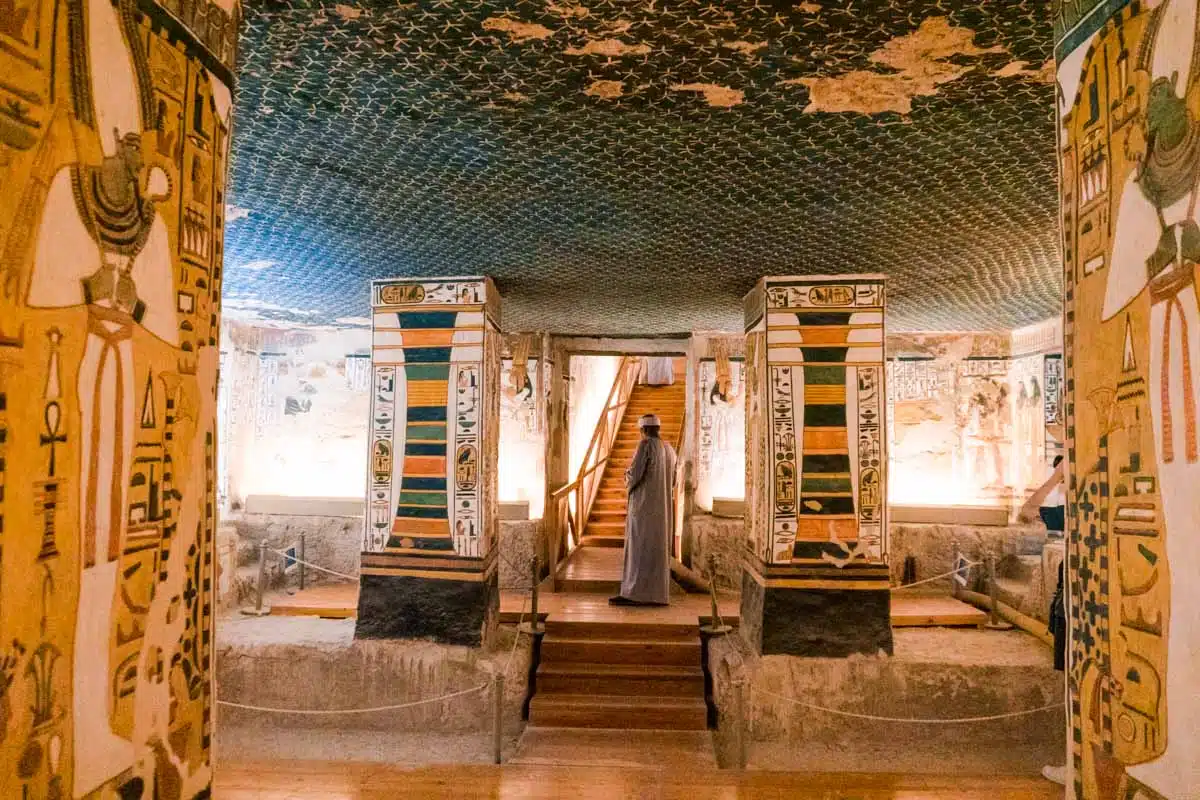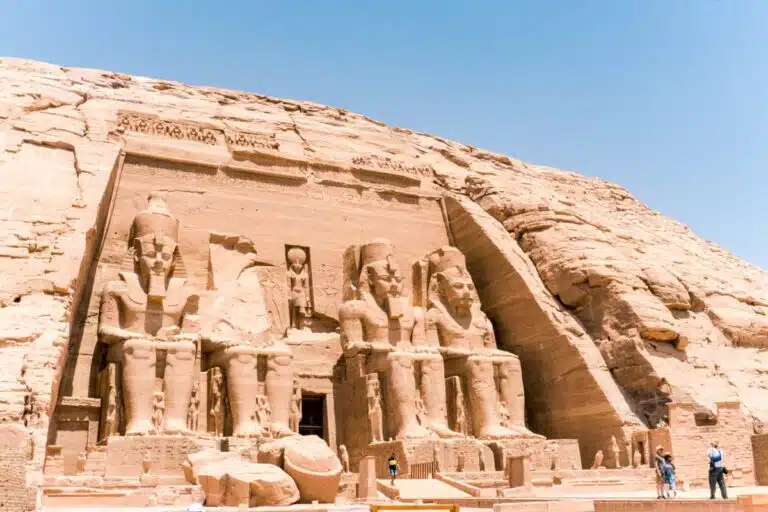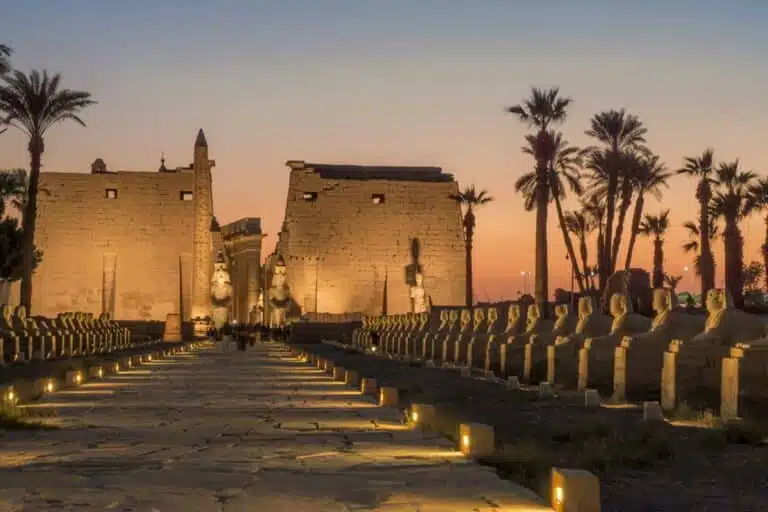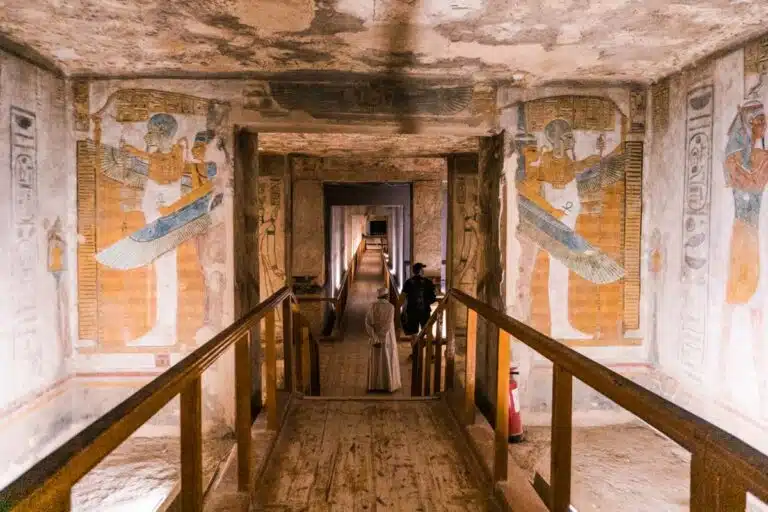Planning to visit Queen Nefertari’s tomb (QV66) in Luxor? Here’s what you need to know.
We’ve all heard of the tomb of Tutankhamun, shining splendidly in Luxor’s Valley of the Kings – but have you heard of the tomb of Queen Neferteri?
This lavish tomb is tucked away in the far less-visited Valley of the Queens and is Egypt’s most striking: a warren of golden illustrations that loom larger than life, underneath a starry-decorated ceiling. It’s a sight to behold.
Want to know what to expect and how to plan your visit? Read on my friends!
Why Visit Nefertari’s Tomb?
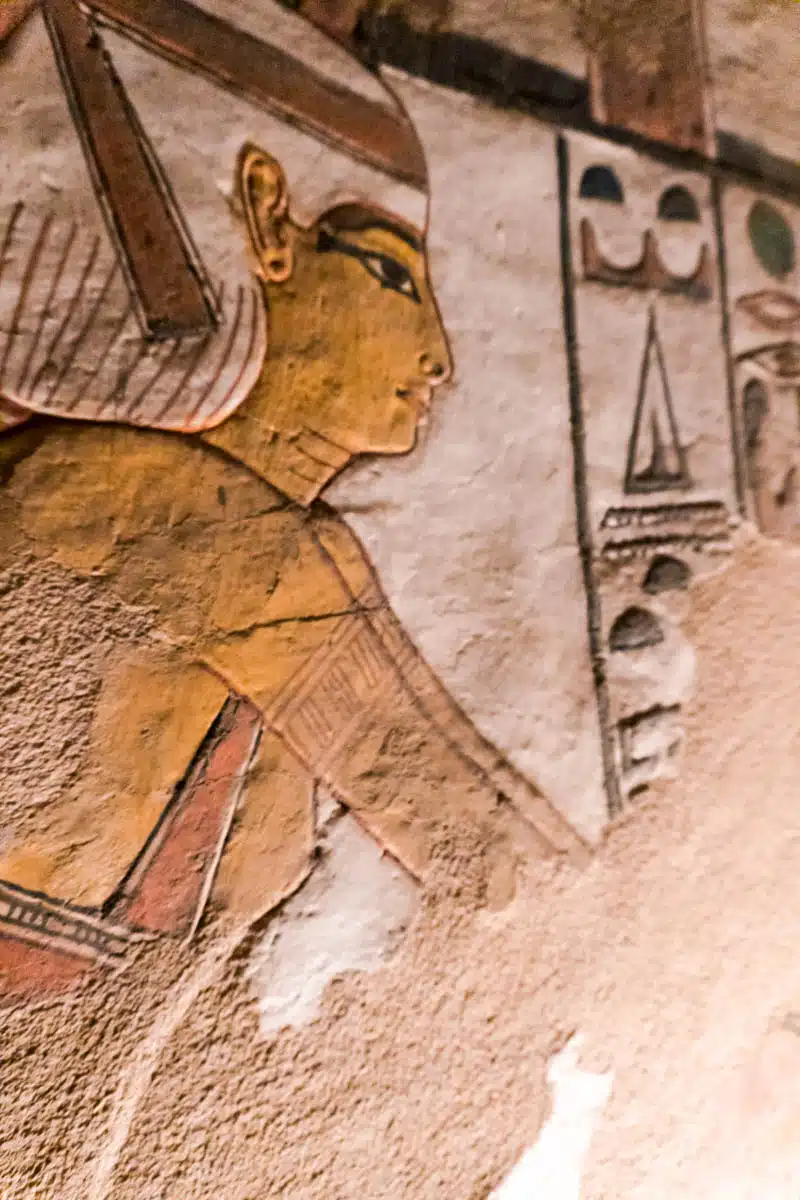
Why visit Nefertari’s tomb? How about an opportunity to see one of Egypt’s most stunning tombs?
Queen Nefertari was the beloved queen of Ramses II (also known as Ramses the Great) – and he spared no expense on her tomb.
Sure, it means venturing to the Valley of the Queens (which you should do anyway) and you have to pay an extra $65 or £55 (1200 EGP) for only a 10-minute viewing, but the beautiful decorations and detailed artwork are more than worth it.
Want to know what to expect when you get there?
The well-preserved paintings in the tomb of Nefertari shed light on ancient Egyptian beliefs, making this tomb one of the most important excavation sites. Many depictions show the Queen with Gods and are associated with texts from the Book of the Dead.
There’s also the significant bonus that Queen Nefertari’s tomb is much quieter than tombs in the Valley of the Kings, so you’re able to explore it without the constant jostling and crowding of the busier tombs.
The History of Nefertari’s Tomb
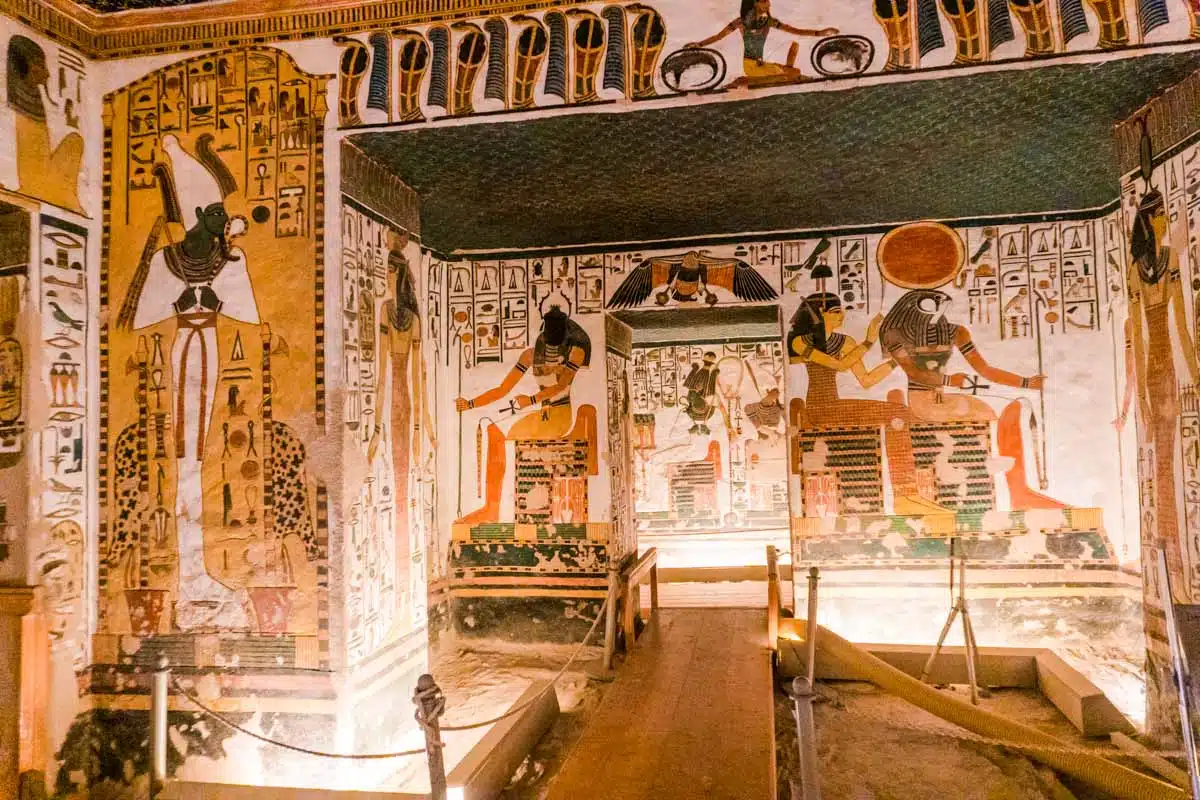
As the Royal Spouse of Pharaoh Ramses॥ – Nefertari had to compete with five wives and hundreds of concubines, yet remained her husband’s favourite until she died in around 1255BC.
Nefertari was Ramses’ first and most significant wife, known as his ‘sweet of love’ – and the history of this elegant construction is just as fascinating as the tomb itself.
The Construction of Nefertari’s Tomb
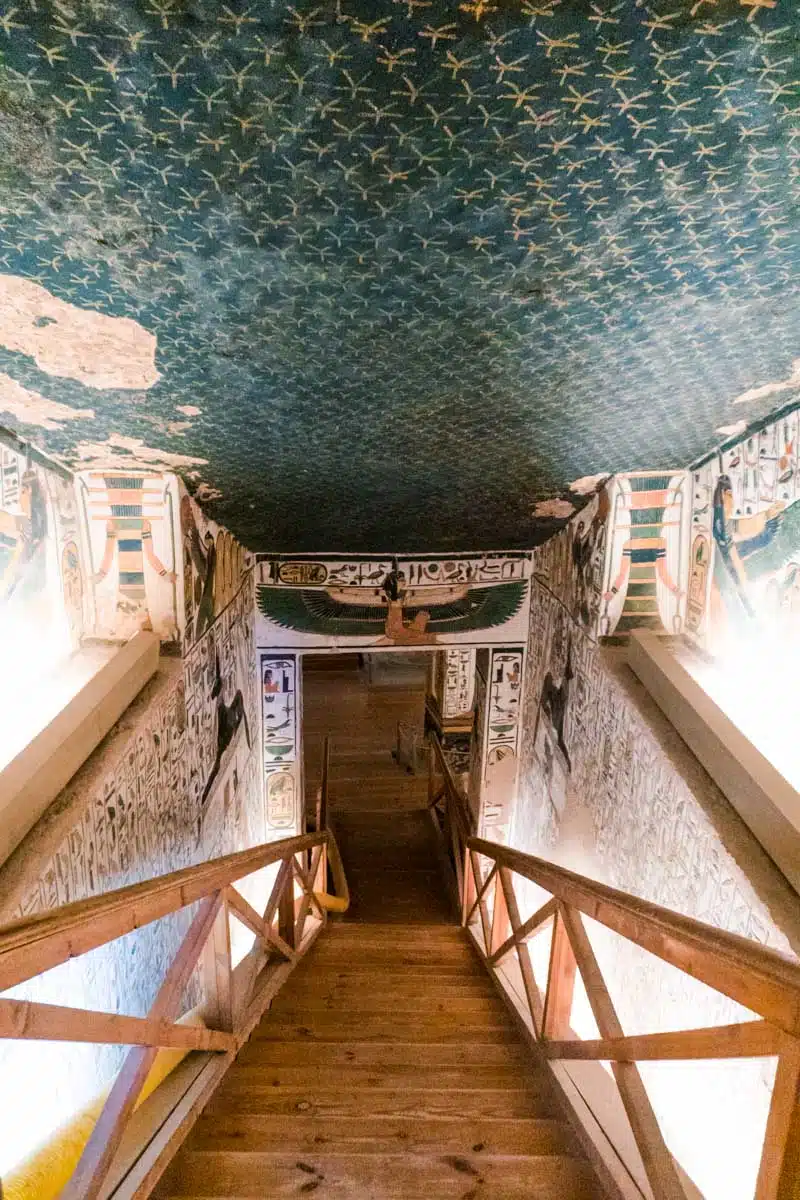
The construction of Nefertari’s tomb began around 1250BC as a tribute from the Pharoah. The workers responsible for its construction were the same men from the village of Deir el-Medina who built the Valley of Kings.
They had finished the construction just in time for the Queen’s burial. The men carved the crypt out of limestone cliffs. Inside you’ll see glowing stars on the ceiling and intriguing paintings from wall to wall that depict the life and death of Queen Nefertari.
A beautiful depiction of the Queen playing a game of Senet is an interesting glimpse into the past.
These intricate decorations garnered Nefertari’s tomb the nickname: the Sistine Chapel of Ancient Egypt.
Decline and Disrepair
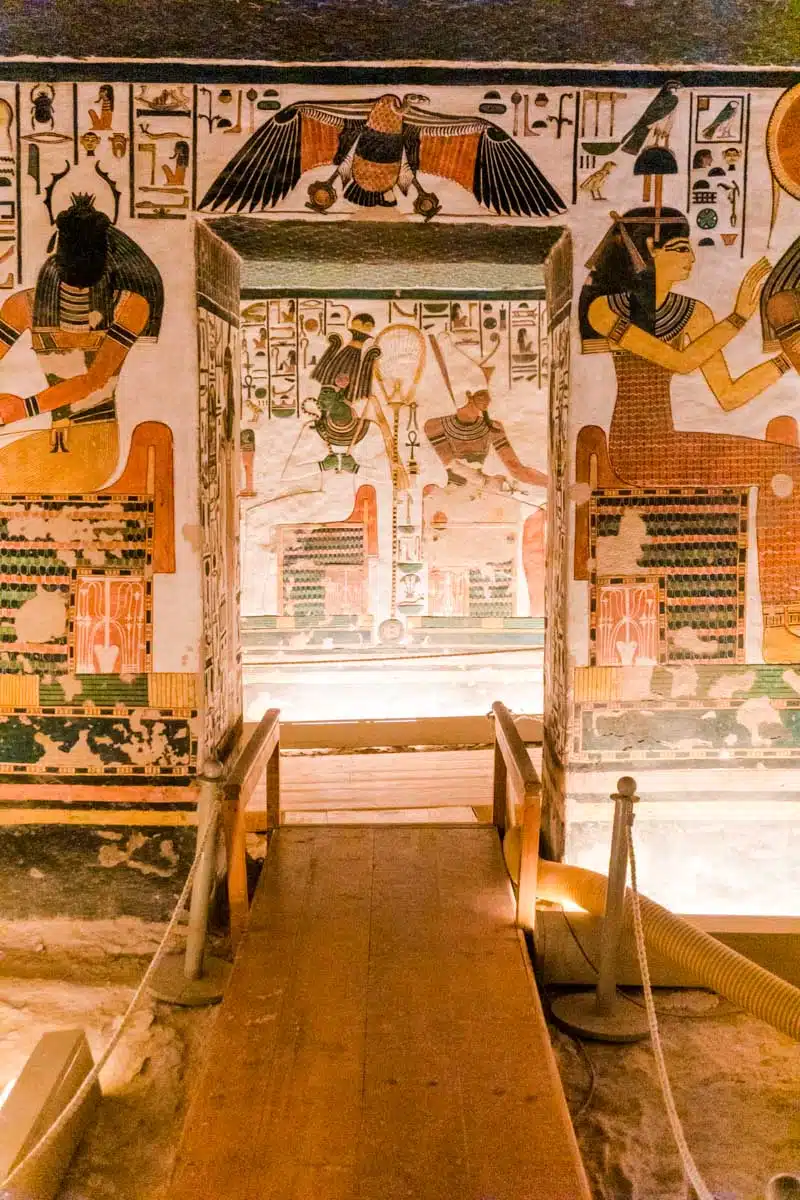
Like all tombs in Egypt, the history of QV66 is no simple one.
As was the practice for all royal burials, Queen Nefertari would have been buried with all the goods and treasures she needed to continue in the afterlife. Yet, by the time the tomb was re-discovered in the 20th century, it was all but empty.
The reason? Tomb robbers.
As the Egyptian civilization began to decline, the royal tombs were no longer protected in the way they once were. By the beginning of the Twenty First Dynasty, robbers freely plundered the tombs in the Valley of the Kings, and the Valley of the Queens suffered a similar fate.
By the time Nefertari’s tomb was unearthed in 1904 by Italian archaeologist Ernesto Schiaparelli, its contents had long been looted and the crypt and walls had begun disintegrating.
All that remained were pink granite fragments from Nefertari’s coffin, a pair of woven sandals, amulets and figurines – and of course the striking interior we see today.
Restoration of Nefertari’s Tomb
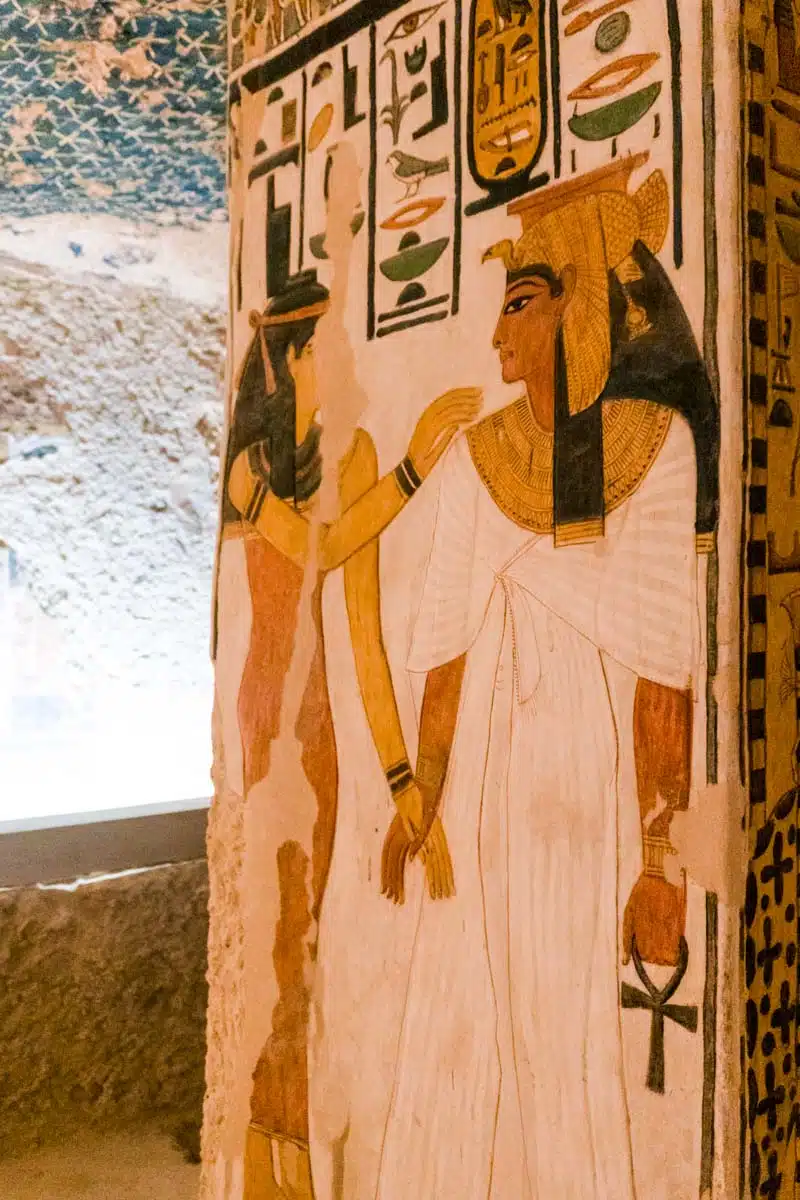
Ever since the tomb of Nefertari has undergone many intense “facelifts” lasting from 1988 to 1992 to restore it to its former glory.
The restoration cost an international team $2 million to complete, funded by the California-based Getty Conservation Institute.
After its discovery in 1904, the tomb finally opened its doors to the public in 1995.
Planning Your Visit to Nefertari’s Tomb
Tours to Nefertari’s Tomb
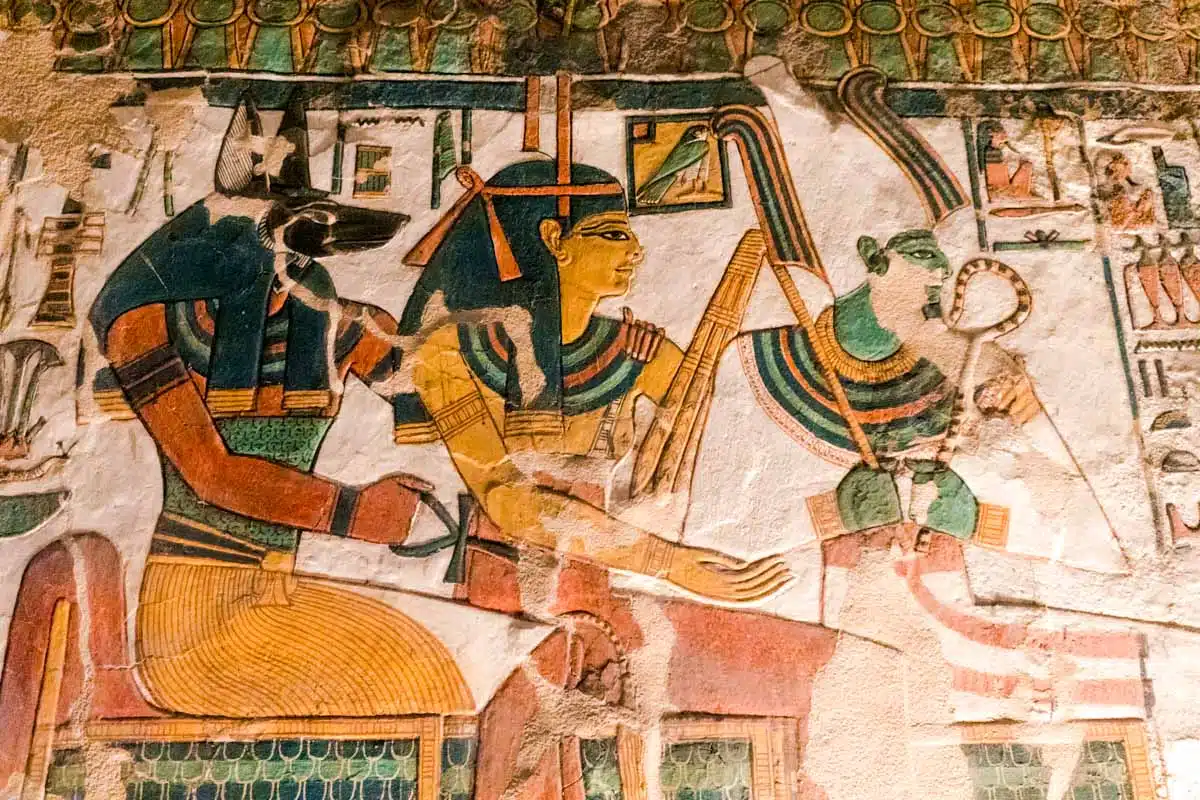
The most convenient way to explore inside the real grave is via an organised tour to the Valley of Queens:
Day Trip
See the wonders of Egypt on a full-day, guided tour:
- Explore the Temple of Karnak, Hatshepsut, Colosseum of Memnon and the Valley of Queens.
- Skip-the-line ticket.
- Covers pick-ups, a live tour guide and a buffet lunch.
- Excludes the entrance tickets to most sites.
Multi-Day Trip
Hop on board a magical cruise along the Nile River:
- It consists of 7-nights and stops at various legendary sites.
- The hot-air balloon ride and entry tickets are included.
- Explore Luxor, Aswan and Abu Simbel.
- Led by an English-speaking guide.
- Skip-the-line ticket.
Visiting Nefertari’s Tomb Independently
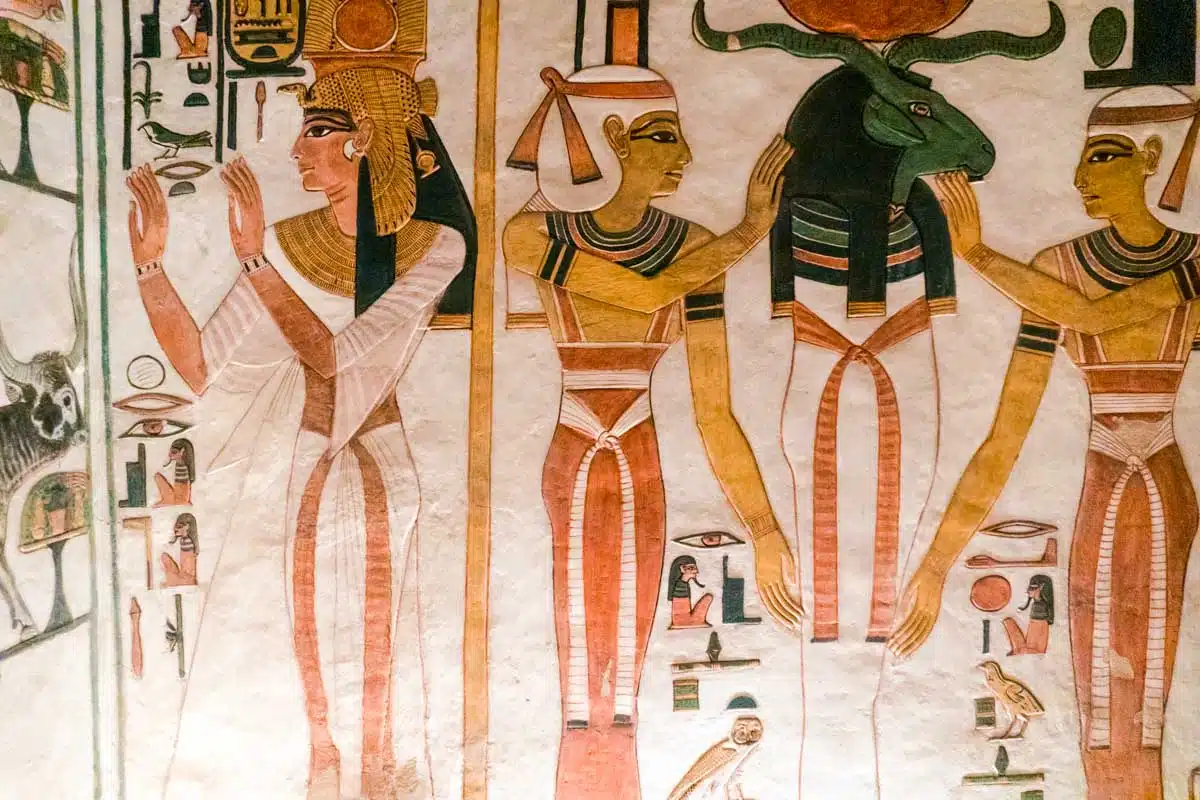
While it may not be as convenient, you can visit Nefertari’s tomb solo. I’ve listed the most efficient means to travel to the Valley of Queens from popular locations.
Entrance Fees
To see Nefertari’s tomb, you need to pay the entrance fees for The Valley of the Queens 50 EGP ($6 or £5). You also need to buy an additional ticket for Nefertari’s tomb, which costs 1200EGP ($65 or £55).
Luxor
If you are staying in Luxor, a taxi ride is 30-minutes and costs between $4 and $6 (£3 – £5).
Aswan
I recommend taking a train from Aswan city, it is the cheapest option and takes only about 20-minutes more than a taxi or car.
After a 3-hour train ride, you catch a taxi from Luxor to the Valley of Queens.
Cairo
If you’re staying in Cairo, it’s best to take a 1-hour direct flight from Cairo to Luxor, which can cost anything from $50 – $140 (41.82£ – 117.10£).
Tip: Use Skyscanner for the best and cheapest available options by Egypt Air.
Nefertari Tomb Address
Physical Address: QV66 Tomb, Valley of the Queens, Al Qarna Desert, Luxor Governorate 1340410, Egypt.
Nefertari Tomb Opening Times
Open from Monday to Sunday. Times vary according to seasons: Winter hours are 6 am – 4 pm, and Summer hours are 6 am – 5 pm.
Where to Stay
For an authentic Nubian experience, I recommend trying the exotic Nefertiti Hotel.
Alternatively, check all accommodation in Luxor.
What to Pack for Nefertari’s Tomb
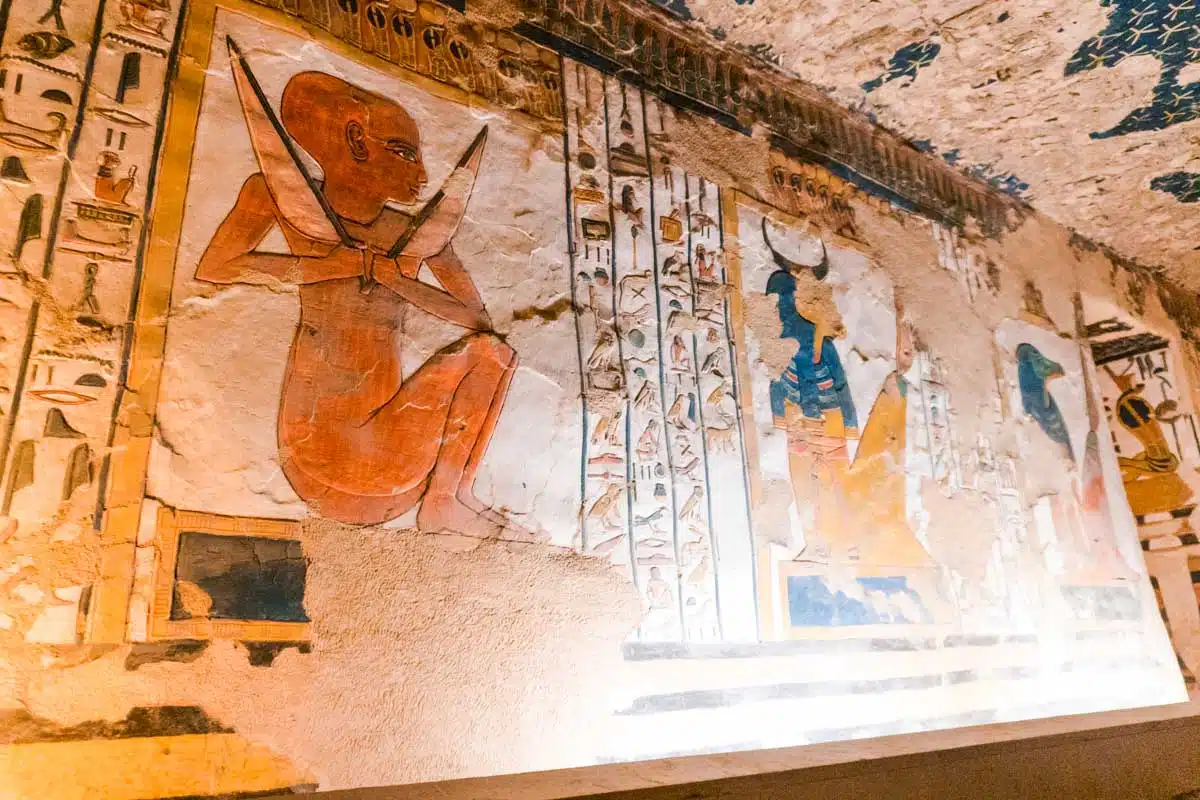
To make the most of your trip to Nefertari’s Tomb, I recommend you bring some essentials. And because we’re talking about Egypt – do not forget to lather on your sunscreen!
Also, bring a hat, plenty of water and comfortable shoes as you’ll explore the tombs on your feet. Read more about what to wear in Egypt to prepare for your journey.
Nefertari’s Tomb: Map
sThe Tomb of Queen Nefertari, Luxor: Read Next
- The Ultimate Egypt Itinerary
- Top Sights and Attractions in Egypt
- Travel Guide: Egypt
- What to Pack for Your Trip to Egypt
- How Much Does it Cost to Visit Egypt?
- Unmissable Things to do in Luxor
- Visiting Luxor’s Valley of the Kings
- How to Plan a Visit to Luxor Temple
- Why You Should Book a Hot Air Balloon Ride in Luxor
Love This? Save and Share on Pinterest
